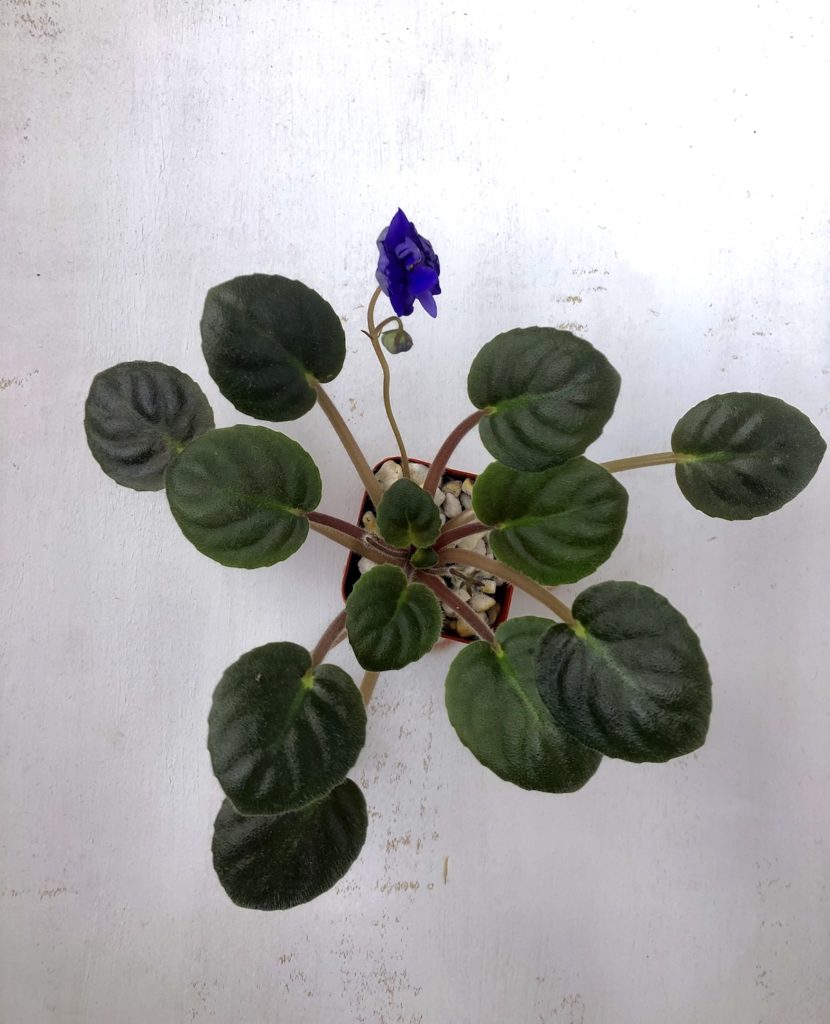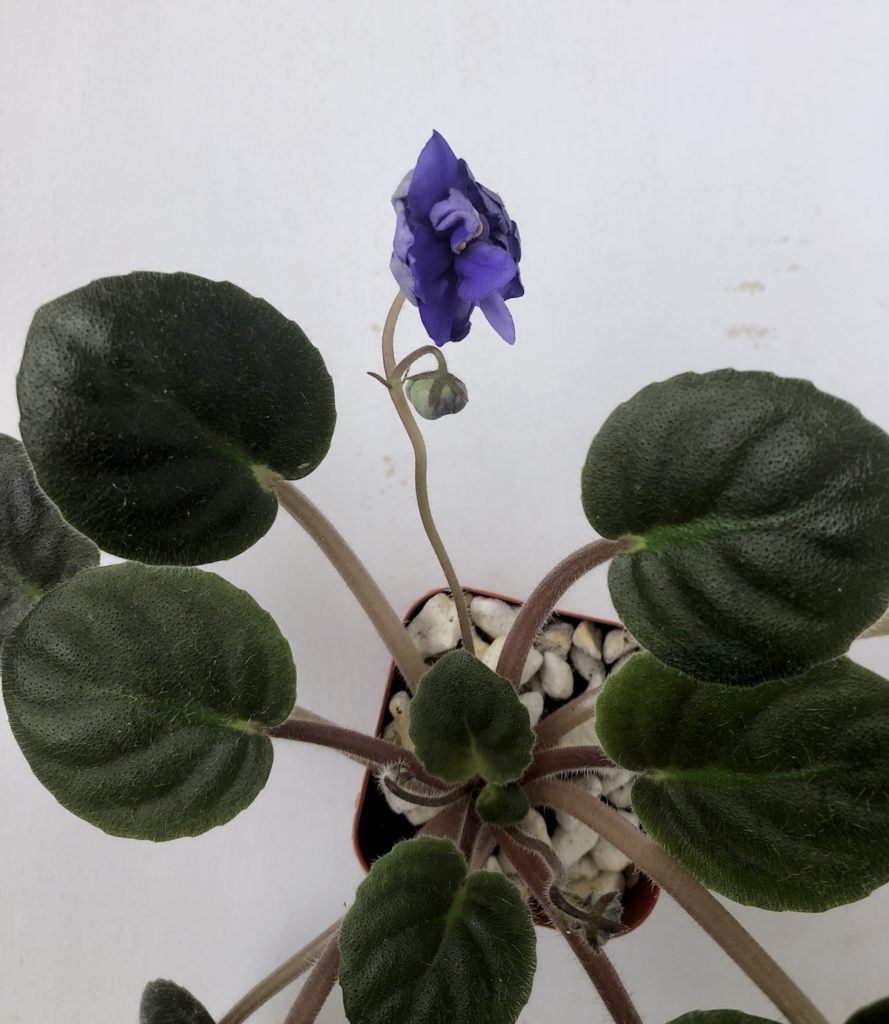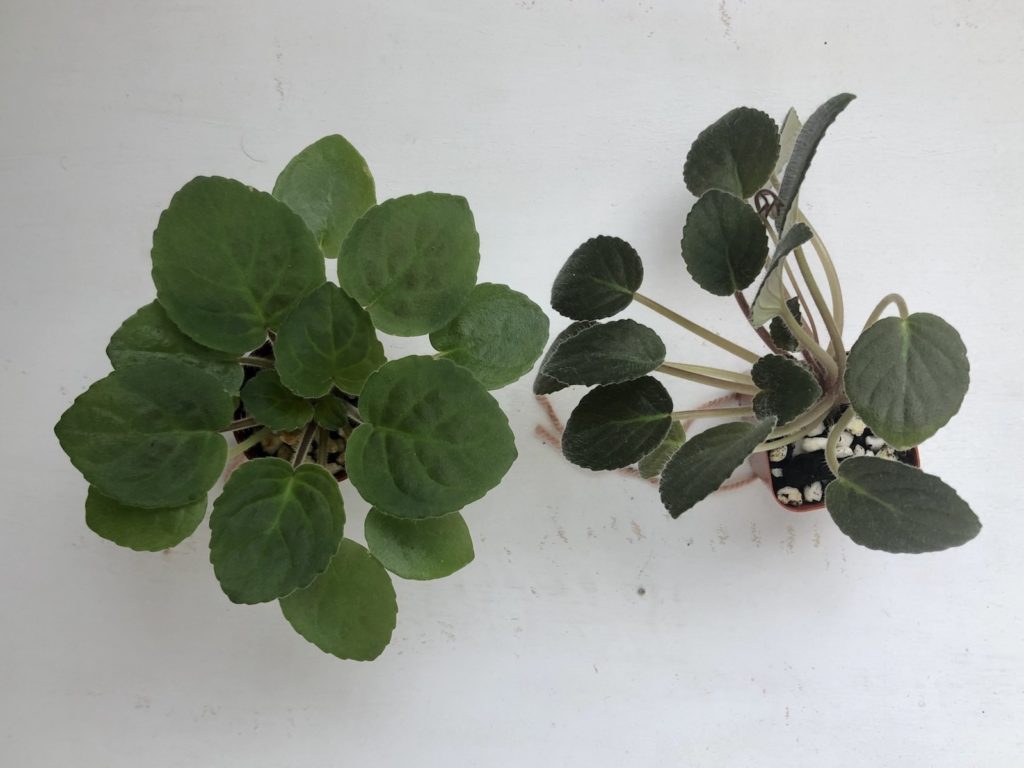Russian violets are Internet phenomena, and I, as a native Russian speaker, spend quite a lot of time trying to find all available information on ‘hybridising like a Russian’.
Some time ago I found a 10 years old article on growing seedlings in a crowded manner (article and discussion are in Russian) to save on shelf space. That sounded like an interesting idea, so I decided to give it a go. That’s how it went for me.
How to grow 100 violets in one 50x65cm tray
The article said that there is a way to get 3-5 new varieties from a cross, growing the plants on 50x65cm space. The idea behind ‘compact hybridising’ is simple – you don’t need to grow the seedlings as show plants, they don’t have to be nice and flat. You keep them crowded, get rid of all that bloom plain, and evaluate the quality of the plant itself at the next step. That sounded reasonable, and I had a massive amount of seeds from 16 crosses, so I was ready to give it a go.
That’s the proposed system:
- Don’t grow seedlings in separate pots. Plant them into shared 50x65cm tray, 10 rows, 10 plants in each – meaning you have 100 seedlings in the tray. That’s all the space this cross will get from you.
Crowded violets will grow upwards, as they don’t have a chance to be flat. They will also compete for light. In order to compensate for less light, you’ll need to keep them much closer to the lamp – 7-8cm from the lamp to the foliage.
Let them bloom in the tray, and discard of all that are below your expectations. Shortlist 5-10 plants that have potential. - Pot your shortlisted 5-10 plants and grow them in the same 50x65cm space – they will grow more freely, so you can evaluate the shape and symmetry. Let them go through the second blooming cycle to make sure they are blooming true.
Discard plants with poor symmetry, unruly foliage, weak bloom stalks at this stage. You’ll hopefully end up with 5-7 plants that bloomed the same in the first and second cycles and have decent plugs. - Plant leaves from your shortlisted seedlings to check whether they bloom true. These plants don’t need to grow nice and flat, so you can again grow 100 test plants in 50x65cm tray.
Seedlings that don’t pass leaf propagation test because they don’t bloom true, are discarded. You’ll hopefully end up with 3-5 seedlings that are worth naming. If you sell leaves of your new varieties, you can use your compact grown test plants from this step as a source of leaves for sale. And your sales photos of the varieties are coming from Step 2, where you grew shortlisted seedlings in a less crowded manner.
The original article also has an extensive description of shelf units and lights suitable for compact hybridising, and as a conclusion, stated that compact hybridising requires 15 times less space compared to the traditional method. Considering that I am extremely space-limited, this system sounded like my life saviour.
How ‘compact hybridising’ worked for me so far
In Russia, we have a proverb that can be translated as ‘it all looked smooth on the map, but we forgot about the ravines’, meaning probably the same as ‘the best-laid plans of mice and men often go astray’. That’s exactly how my crowded growing went.
What worked well
- Watering one tray is so much easier than 100 separate pots! It also dried out much slower, meaning I had to water the seedlings less often.
- I managed to keep 700+ seedlings on less shelf space than I used for 250 seedlings in individual pots.

My ‘lettuce’ style violet seedlings
What didn’t work well
- In theory, we plant the seedlings, they bloom, we sort through them. In reality, they don’t bloom at the same time – it might take months for all plants in that tray to finally bloom. And in such a crowd it is nearly impossible to take out plants with plain blooms without disturbing all seedlings around.
- In theory, crowded seedlings compete for the resources and we let the best violet win. In reality, it works well with standard+standard crosses, when all seedlings are of the same size. In standard+mini or standard+semi-mini crosses, bigger seedlings quickly take over, and smaller ones lose the battle not because of lack of vitality, but because of their size. And now imagine crosses with known slow-growers, like girl-foliage, and imagine how quickly your regular boy-foliage pack of seedlings will win all the space.
- In theory, each plant has 5×6.5 cm space to grow, and it behaves as expected, using the allocated potting mix volume. In reality, my seedlings refused to have small accurate root balls – they had long, wide root systems, violating (pun intended) each other’s borders and creating a collective root system in the tray. So when the time came to separate them, I had to disturb plants a lot and it took them a while to recover.
- In theory, we choose seedlings we like in the first blooming cycle, give them some space and evaluate the plants’ shape in the second blooming cycle. In reality, seedlings that survived their first Hunger Games and were relocated to the Winners Village looked awful. They had to be fully regrown in order to see what they really look like. They came out of the tray having small to medium-sized leaves on long brittle stems. Getting their own pot and some space, they immediately started growing bigger leaves, trying hard to form a proper plug. And this foliage regrowing activity took months.
- Grooming is simply impossible in the crowd – every time I tried to remove a rotting leaf, I was breaking some good ones around it. Partly because of all seedlings having thin long leaf stems. So I gave up and let it rot. You know, like in a real jungle. To be fair, it never caused any issues, except for rotting organic matter inviting springtails in. I’ve never had them in my collection before, and now it is impossible to get rid of the critters…
- I used more potting mix filling in a tray than filling in pots that fit into that tray.
- It took my seedlings ages to start blooming in the overcrowded environment. I potted some seedlings from each cross before planting the rest to trays. They developed months earlier and were well on their way to maturity and a second bloom cycle when the crowd started shooting up its first buds. So I saved some space but wasted heaps of time. Not sure if it was a win-win strategy.

Finally potted, the seedling starts to flatten and takes more space than it should – because of long leaf stems 
It is impossible to evaluate the plant’s shape and bloomstalks quality 

Seedling potted up a while ago (left) and grown in a tray (right)
Traditional vs compact growing
Comparing ‘compact’ growing in trays with ‘traditional’ growing in little pots, the latter worked much faster for me. When I grew seedlings in pots:
- I saw the first buds as soon as five months after sowing
- the first bloom opened six and a half months after sowing
- I started pollinating my new seedlings seven months after sowing
- 14 months after sowing I had the first seed pod on a plant from that batch ripe and ready
- all plants from that batch bloomed within a year after sowing.
When I grew seedlings in trays:
- the first bloom opened a year after sowing
- active blooming started 15-17 months after sowing
- nothing is pollinated because I have so many yet to bloom and don’t want to start pollinating less than the best plants
- I am currently dealing with a few hundreds of seedlings I sowed 16 and 18 months ago, and they are still more lettuce than blooming plants.
I can easily agree that I did something wrong with ‘compact growing’. Maybe the plants needed to be much closer to the lamps or something else. Maybe growing violets in a crowded manner is a hardcore science rather than a hobby activity.
However, in the time I spent on ‘compact’ growing, I could easily do two rounds of traditional growing in pots and have more blooming plants earlier.
In my experience over the last three years, the longer seedlings grow crowded, the longer it takes to make them bloom. Transplanting a big seedling with a massive root system from a tray into a pot sends it into transplant shock and the plant takes its time to recover. However, when they are transplanted on a reasonable schedule, they develop faster, they are not shocked by a pot-up, and they want to grow right and bloom asap.
For me and my conditions, the only reason for keeping seedlings in crowded trays for months is having a backlog of plants that can’t be potted up due to a lack of space. Frankly, after three years of constant transplanting, sowing, repotting, pollinating, I’d rather keep my ‘backlog’ in seeds form in my fridge.
Moving forward, I aim to sow seeds in small batches, and to have plants at different stages of development in the pipeline. We’ll see how these good intentions work…
